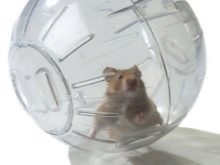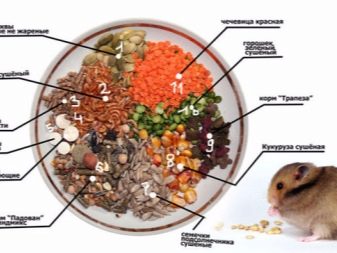How long do Dzungarian hamsters live?

The Dzungarian hamster is a cute and very unpretentious animal. The length of his animal life can depend on factors such as heredity and breed. Rodents can rarely live up to 3 years of age. For this reason, when buying a Dzungarian hamster, it is important to determine its age.

How many years do they live in nature?
The Dzungarian hamster has a dark (gray) stripe on the back, a very short tail, which is almost impossible to see, especially when the rodent is sitting. There are significant white blotches on the fur. This animal usually lives in arid steppes and semi-deserts, in Western Siberia, Dzhungarskiy Alatau, Khakassia. The main area is Dzungaria, which is located between eastern Kazakhstan and northwestern China.
In this territory, in their natural habitat, small animals are always in danger. Dzungarian hamsters can be trapped by such predators as bears, owls, hawks, eagles, snakes, foxes, wolves and other large animals. Winter is an unfavorable phenomenon for the body of the Dzungarian hamster. He has a hard time enduring such climatic conditions. That is why in the wild these rodents can live only 1-1.5 years, while females usually live longer than males.
There is no need to domesticate a wild rodent, since the Dzungarian hamster is a vicious and stubborn animal. For the home, they buy Dzungarian hamsters, which were bred as a result of the work of breeders.


Life expectancy at home
The owner of the Dzungarian hamster can surround his pet with kindness, care, love, attention and provide him with optimal living conditions. If the hamster lives at home, then he will be able to live much longer - up to 2-3 years. But there were also such cases when Dzungarian hamsters could live for more than 4 years. You need to come to terms with the fact that small mammals do not live long, even if they are well looked after.

Factors Affecting Lifetime
Dzungarian hamsters are very small and vulnerable creatures. It is necessary to provide the pet with the best living conditions. It is also necessary to take care of the habitat of pets. Dzungariki cannot stand other pets near them. The most important thing for their content is giving each hamster his own cage. If several animals live in one cage, then they will constantly fight among themselves. This lifestyle will quickly shorten the lifespan of the Dzungarian hamster.
Cotton wool should not be allowed in the pet's dwelling... If cotton wool is accidentally wrapped around the pet, then the rodent may die from suffocation. If the hamster swallows a little cotton wool, he will have digestive problems. If your pet wants to make a nest, you can put a napkin or paper on it. These materials are safe.
The Dzungarian hamster needs a lot of attention. You need to play with the animal, talk, show your care and love. You don't need to turn on TVs, radios, or other equipment that can generate noise for your hamster. The animal is very sensitive, if there is constant noise and din around it, then the hamster's health will deteriorate.
Also, Dzungarian hamsters need to be protected from direct sunlight. Animals do not like too bright light, it worsens the health of the pet. The dwelling must be positioned so that the sun's rays cannot enter it. In order for a rodent to live a long time, you need to take care of his home in a timely manner. It is impossible for garbage and waste products to accumulate in the cell. Litter must be removed 1 time in 2 days. A complete cleaning of the cage should be done every week.


Diseases
Various diseases have a bad effect on the immunity of the Dzungarian hamster. If the pet is sick, then it will live less. Symptoms of illness: lethargy, low activity, the pet is drowsy, the quality of the coat deteriorates, breathing becomes intermittent. If at least one sign appears, then an urgent need to consult a veterinarian. If you do not take action, then the disease can develop.
There were times when the hamster could fall. Animals are playful and curious, so they can sometimes climb on the edges of the table and accidentally fall. If this happens, hamsters can injure their paws, get bruises and scratches. There is no need to heal Dzungarian hamsters yourself. Better to take the rodent to the vet.
Animals can get colds, then they will sniff and sneeze. If the pet is sick, then he needs to pay more attention and give food, which contains many vitamins. Only a veterinarian should prescribe medications and injections. If a Dzungarian hamster does not eat well, it may have dental problems. Some teeth may be sore or elongated. If this happens, then the veterinarian must shorten them.
If Dzungarian hamsters have a stomach rumbling, loose stools appear, this means that the animal has digestive problems. There were such cases when a tumor could form in a Dzungarian hamster. Only a veterinarian can find it, so the rodent should be shown to a specialist periodically.
You need to know that diseases may not always appear due to the carelessness of the owner. Although in most cases everything depends on the pet itself - immunity, character, heredity are important.

How to contain it correctly?
Dwelling
Dzungarian hamster cage should be with horizontal rods. Since you can easily install a wheel, a drinker, a feeder on them.If the cage is with horizontal rods, then the Dzungarian hamster will be able to climb the walls and cling to the ceiling with its paws. The main thing is that the distance between the rods is about 11 millimeters so that the Dzungarian hamster cannot escape.
For these animals, a one-story dwelling is standard. These cages are cheap and can be easily cleaned. A wide variety of accessories can be placed in two-story and three-story cages. You can also purchase wheels, tunnels and labyrinths. If the dwelling is multi-storey, then the Dzungarian hamster will sleep on the top floor. The lower floor is for games.
The hamster owner sometimes wonders how much his pet can run per night. To do this, you can purchase a cage with a mileage counter. Together with the cage, you need to buy a walking ball.



Nutrition
First you need to figure out what products are allowed for dzungariks. These animals need to eat in a variety of ways. You don't need to give your hamster the same food every day. But dry food should be given daily. Large foods (vegetables and fruits) must be cut. The optimal piece size is 1 centimeter. It is necessary to periodically give products that are additives to dry food.
- White and green vegetables: squash, cucumber, turnip. Colored: carrots, pumpkin. It is enough to give 2 times in 7 days.
- Grass and herbs should be given once every 2 days.
- Foods that contain proteins: meat and eggs. They must be given once every 7 days.
- Fruits, berries and dried fruits - once every 14 days.
- Less often you need to give nuts and seeds.
Ensure that all food is fresh and of good quality. All spoiled food should be thrown away. Fruits and vegetables should be thoroughly washed and peeled. Many owners use ready-made dry food. They must be marketed under reputable brands that specialize in rodent feed. These foods contain essential nutrients, minerals and vitamin supplements to help keep your hamster healthy. Some foods contain foods such as dried vegetables, fruits, and other nutrients that balance the diet.


For a pet, you need to select high-quality food, which is produced by trusted companies. It is recommended not to purchase cheap feed. It is necessary to buy those that are intended specifically for the Dzungarian breed hamster, since prohibited substances may appear in mixtures for other species. The daily intake of food is 1 tablespoon. A balanced and nutritious diet does not require large expenditures.
What should not be given to Dzungarian hamsters? Consider a list of prohibited foods that can kill the animal. A fluffy pet can be poisoned by substances such as: hydrocyanic acid in almonds, nitrates in watermelon. Persimmon can provoke constipation, and spices have a laxative effect. Do not give bread and beans to the Dzungarian hamster, because they form gases in the animal's stomach, and this can even kill the pet.
Fatty foods should not be given, seeds should be given only in rare cases. From fruits, you cannot feed the hamster avocado, and it is also forbidden to give fried food. Do not offer pasta to the animal because it is too hard. Citruses can cause an allergic reaction. For your pet to have a good digestive system, you need to follow these guidelines.

Hygiene
Hamsters need to be cleaned in case of any need. For example, you can wash a Dzungarian hamster if the coat gets dirty or parasites appear. But the animal itself is clean. Even if a mess develops in the cage, the hamster himself always rinses. If the pet is old or sick, then he will not be able to wash himself. In order for the animal to smell pleasant, you need to constantly clean up its home. There are several methods for bathing a Dzungarian hamster. Hygiene procedures can be done at home.
- Sand baths. You need to purchase a bowl and sand for your hamster.You need to pour sand into the bath and run the animal there. It will happily roll from side to side in the sand. If the hamster gets tired of bathing, then you will need to immediately remove the basin.
- Wet wipes and cotton pads. If the hamster accidentally gets dirty and cannot clean himself, he must be wiped off with a cotton pad, which was previously soaked in water. You can use a simple damp cloth. It is best to choose baby wipes, as they do not contain chemical elements. After the procedures, the animal must be dried.
- Swimming in the water. You can wash your hamster under a stream of liquid, it should be warm, not hot. The head and muzzle of the Dzhungarik must be left dry. Wash carefully and quickly. Then the pet needs to be dried using a hair dryer, which has a minimum speed. Or, you can gently dry your hamster with a soft towel. The pet must be sheltered from drafts.

The Dzungarian hamster is a very unpretentious pet. The main thing is to properly care for him, create comfortable living conditions, feed him well and correctly in order to prolong the life of the pet.
For information on how to properly care for a Dzungarian hamster, see the next video.








